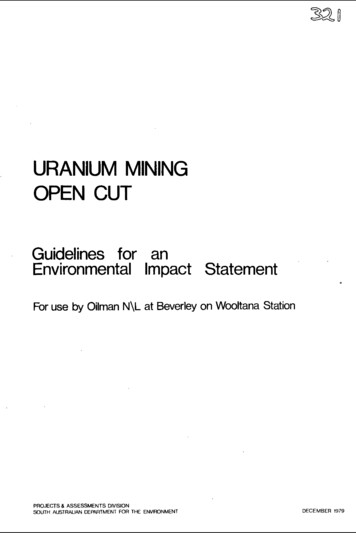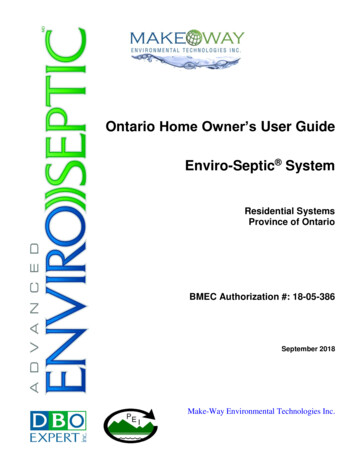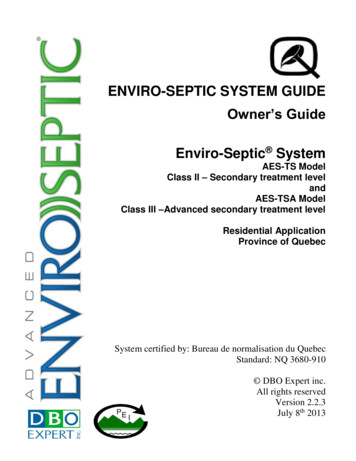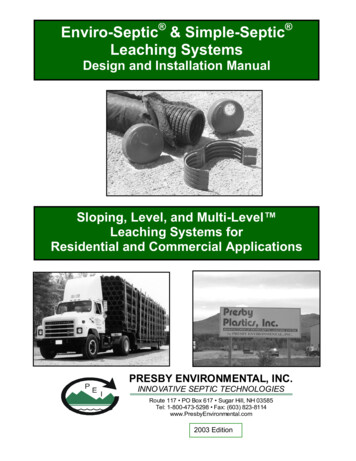
Transcription
MI,oURANIUM MININGOPEN CUTGuidelines for anEnvironmental Impact StatementFor use by Oilman N \L at Beverley on Wooltana StationPROJECTS & ASSESSMENTS DIVISIONSOUTH AUSTRALIAN DEPARTMENT FOR THE ENVIRONMENTDECEMBER 1979
URANIUM MININGOPEN CUTGuidelines for anEnvironmental Impact StatementFor use by Oilman N \L at Beverley on Wooltana StationPROJECTS & ASSESSMENTS DIVISIONSOUTII AUSTRALIAN DEPARTMENT FOR THE ENVIRONMENTDECEMBER 1979
1.INTRODUCTIONThe main text of an environmental impact statement should be astraightforward document treating its subject in terms which are clearand readily intelligible to the general reader.Technical detail shouldbe included in an appendix so that the environmental impact statementforms a complete and self - contained entity.The discussion should focus attention on the salient features of theproposed operation, and the environmental considerations associated withAlternatives should be discussed where they offer a practical andthem.potentially acceptable way of achieving the principal objectives;alternatives should be treated in sufficient detail to make clear thereasons for selection of a particular option, the less clearcut thedecision the more supporting detail should be provided.The document should include references to the sources of technicaldata and to organisations and individuals consulted so that interestedparties can examine the basis for environmental decisions.Relevantdiagrams, figures and maps should be included but the presentation shouldbe such as to minimise, as far as convenient, the cost of preparation orof obtaining the environmental impact statement, and of making itavailable to the public.The following guidelines indicate the areas which should beconsidered in the preparation of an impact statement.They shouldhowever be dealt with only to the extent considered appropriate to thedevelopment under consideration with a view to concentrating on the moresignificant environmental impacts.2.CONTENTS OF ENVIRONMENTAL IMPACT STATEMENT1.Title of Proposed Development.2.Name of Proponent.3.Summary.The environmental impact statement should include a concise summaryof relevant information to enable the reader to obtain a quick butthorough understanding of the proposal and the resulting environmentalimpact.
- 2 -That summary of al . matters pertaining to the E.I.S. should be based onthe following sub - titles:(a).Objective of Proposal(b)Background of the proposed development(c)Existing Environment(d)Description of Proposal(e)Description of alternatives both to and within the proposal(f)Environmental Impact(g)Environmental Safeguards Proposed(h)Monitoring and review(i)Map(s) showing Location,' Boundary, and Access.The general content of the impact statement should include thefollowing:4.Broad Objectives of the Proposed DevelopmentThe E.I.S. should be introduced with a statement of the objectivesof the proposed development.5.Background to the Proposed DevelopmentThe E.I.S. should fully,- disclose the decision- making process thatled to the objectives.As a result, consideration must be given to anyknown alternatives to the proposal which could feasibly attain the basicobjectives, and why they were rejected in favour of the ultimate choice.The specific alternative of 'no project' must also be evaluated.Attention should be paid to alternatives that would substantially impedethe attainment of the project objectives or add significantly to cost,but would reduce the environmental impact of the proposed development.This section should contain the following sub - sections:(a)Analysis of the need for the proposal including an evaluation of theadvantages and disadvantages of not proceeding with the proposeddevelopment and of other alternatives to the proposed development(including prdceeding at different rates).
- 3 (b)Description of the proposal including:anticipated cost;time -scale of implementation and mine -life;proposed uranium production levels and value ex -mine;projected markets for and uses of uranium produced;alternative available processes and combinations of processes;reasons for selection of preferred process.(c)Resource requirements for the proposal:.resource consumption expected (energy, water, etc);options available for supply of resources;reasons for selection of preferred options;transportation of product;.infrastructure requirements and public facilities required.
- 4 (d)Locational considerations for the proposal and its elements,including:location proposed;total area required;land title;land form, (geology, pedology, seismicity, hydrology, etc);alternatives available;reasons for selection of preferrea options.Workforce requirements: proximity:, number, skills.6.Description of the Existing EnvironmentA description of the existing environment, on both a local andregional basis, is required to gain a knowledge for baselineenvironmental date required for process development, an evaluation of theimpact of the proposal and the subsequent monitoring programme.The factors to be considered are listed in Appendix A.7.Description of Proposed DevelopmentThe E.I.S. should describe the proposed development.The socialtechnical and broad economic characteristics of the uranium miningproject and associated facilities, both public and private should bediscussed.Adequate information and technical data, including maps,flowsheets, diagrams, photographs, etc., should be presented to allow acareful evaluation and review of the proposed action.Reference shouldbe made to any further documents which describe the proposal in moredetail.Information should be included on the following aspects of theproposal:(a)Location of the mine and ore body; location in reference to readilydetermined datum.Depth, thickness and shape of ore body. (includeplans /sections)Describe ore mineralogy, chemistry, tonnages and grade.(b)Geological, pedological, hydrological constraints on site.(c)Extent of working cut;(d)Description and Capacity of crushing and treatment facilitiesrequired.method of mining, groundwater diversion etc.
(e)Volume or ore stockpiles and proposed locations.(f)Volume of overburden, waste stockpiles, tailings dams etc., ana.proposed locations.(g)Treatment processes proposed.(h)Chemistry and nature (physical and chemical) and volumes of theconcentrates.Equipment involved in concentrating, drying andpackaging.(i)Chemistry, nature, volumes and management of waste products.Disposal practice and management proposed, (liquids, solids, gases.)(j)Noise levels, on site and at site boundaried should be estimated.(k)Township:size required, proximity to operations, facilities,amenities, and visual appearance of township and associateddevelopments;(1)social structure.Workforce requirements in terms of numbers, skills etc.:.Mine.Treatment PlantSupporting facilities.(m)Construction.Water supply requirements:including quantity and quality for humanconsumption, ore processing, domestic consumption (non potable).Alternative sources should be discussed.(n)Energy requirements: quantity of energy required (e.g. kW per annum)and types of energy which can be utilized (e.g. coal, oil,electricity, gas etc.)(o)Access and transportation requirements.this should include volumeor weight for people, goods, products, wastes etc. into and out ofthe township, between the township and the mine and processingplant, between the mine and processing plant and for transportationof the final processed product.Types of vehicles to be used, roadrequirements and other transport facilities required should bediscussed, and examined in relation to existing facilities.(p)Visual appearance of mine, processing plant and township should bediscussed (use photographs and sketches).
(q)Construction of plant, township and associated developments volume, nature and source of construction materials and mode oftransport to site.(r)Construction schedule.(s)Rate of mining and life of mine.(t)Economic AnalysisFor the public document, a broad analysis of theviability of the proposal is required.Information on the followingwill be required but may be given in confidence where commercial'considerations' could be compromised by publication:(1)Production tonnages(2)Capital costs(3)Operating costs(4)Rate of return(5)Effect on balance of payments(6)Source of funds(7)Investment required for infrastructure.(u)Rehabilitation proposed:8.Environmental ImpactThere should beof all disturbed areas.assessment of the direct and indirect impacts ofthe uranium mining and processing operation with associated developments,as proposed in Section (7), based upon the description of the existingenvironment provided in Section (6).We consideration should be givento both the short -term and long -term effects of construction, operation,transportation of products and disposal of wastes, and of associateddevelopments like township establishment and operation and powersupply.A summary of factors requiring study and a description of thescope of such a review is given in Appendix B.Such an assessment of the environmental impact will also enable theproponent to instigate design changes at an early stage to minimize theimpact of the proposal.9.Safeguards and StandardsThe safeguards and /or standards proposed to minimize theenvironmental effects of the proposed action should be discussed.Reference should be made to existing environment legislation (both Stateand Federal), and relevant codes of practice.
7 -Reference should also be made to international safeguards andstandards which are applicable to uranium mining proposals.In.particular, emphasis should be placed on the occupational healthstandards for those people involved both directly and indirectly with theproposal.The safeguards and standards should also consider the ultimaterehabilitation of the mine location and the means to achieve this.10.Monitoring and ReviewIn order to monitor the environmental impact of the uranium miningproposal after commencement of operation, base -line data extracted fromthe survey of the existing environment is necessary to gauge relativechanges in environmental parameters.These studies should be made over atime span long enough to obtain information on any seasonal or long termchanges, should be commenced prior to operations and should continueuntil long term impacts are fully documented.Monitoring is required during construction of the township and overthe operational and post operational phases of the work to cover allthose areas likely to be affected by the mining operation, and associatedactivities.It will be necessary to carry out a comprehensive long -termmonitoring programme once the mine is operating in order to check theeffectiveness of the safeguards and standards that have been set.Theprogramme will use the base -line data to distinguish between natural andartificially induced changes in the environment.If monitoring gives anindication of environmental degradation, there must be provision indesign to allow for remedy and for tightening of the initial standards.11.Public ParticipationThe level of public involvement in the planning and decision makingprocess leading to the compilation of the environmental impact statementshould be described.
812.Sources of InformationThe sources of information (e.g. reference documents, literatdresources, research projects, authorities consulted) should be cited.13.AppendicesAdditional information relevant to the Environmental Impact.Statement but not appropriate for the text should be included in theappendices. (maps, graphs, tables, photographs, reports, etc.).
- 9 -APPENDIX AThe Existing EnvironmentThe description of the existing environment falls into three groupings:(i)(i)Abiotic characteristics(ii)Biotic characteristics(iii)Human environment characteristicsAbiotic characteristicsA.Terrestial1. Geomorphology -land formelevation (include contour map of site)unique physical features.2. Soils-profile of soil type and extent of each,with emphasis on land potentiallyaffected by erosion and sites fortailings and water impoundment structures.-physical, chemical and biologicalcharacteristics of soils affected bydevelopment.3. Geology-productive capacity.-general description of geology of site.-seismicity (i.e. probability ofearth -quakes.-mass movements, including erosion andsedimentation.4. Hydrology-description of surface and undergroundwater systems with reference togeological extent, flow capacity, waterquality storage capacity, recharge areas;(detail required depends on thesignificance of potential use or impact).-incidence of flooding which could affectmine site
- 10 -5. Resources-sources of construction materials on botha local and regional basis.-on -site minerals, metals, precious stones.-climatic characteristics (rainfall/B. Atmosphericintensity, temperature, wind,evaporation).-air quality - particulates, gases, odours.-plant species and recognizable vegetation(ii) Biotic Characteristics1. Biologicalcommunities, characteristics andassociations.condition of vegetation.-fauna species, communities andassociations.-delineation of faunal habitats (includingbreeding grounds) and description ofspecies supported.-significance of vegetation associations,faunal habitats or any individual specieson a regional basis; including unusual,unique, rare or endangered associationshabitats or species.(iii) Characteristics of the Human Environment1. Population-distribution, occupation and employmentdevelopment &characteristics, structure andstructure.description of existing population andany trends that are evident;2. Land Use-historical development;
existing land uses and developments inthe location of the proposal or in itsvicinity; including open space,recreational, rural, residential,commercial, industrial, mining andquarrying;-features and sites of cultural andscientific interest; particular emphasisshould be placed on sites, and relics, ofAboriginal and archaeologicalsignificance,-barriers (fenced and restricted areas),-access, utility and transportationnetwork;-service corridors (road, rail,powerlines, pipelines etc).3. Facilities and-existing infrastructure and facilities inthe region including education, health,infrastructuresocial services, water supply, telephoneelectricity, gas, transport, recreationand leisure, shopping facilities,4. Activities-infrastructure negotiations with-appropriate authorities.-existing levels of human activity inrelation to (1), and (2) above;5. Wastesexisting nature and levels of wastesgenerated in the region and the methodsand locations of disposal and these;
- 12 -APPENDIX BEnvironmental Studies1.The recommended environmental studies may require revision asfurther information on the proposal becomes available.For each study,detailsof the factors considered to be of some importance are included.2.3.Study Areas(a)Mine locality(b)Associated development(c)Human environmentRecommended StudiesA.Mine Locality1. Geomorphology, Pedology; Geology; SeismicityA description of the major geological aspects of thearea should be provided.The detail required will dependupon the nature of the specific operation to be undertaken;for example, the construction of tailing dams would require adetailed description of soil and bed rock types.Thepreparation of a landform or contour map, and an evaluationof the erosion susceptibility of the soil (e.g. wettability,infiltration, run -off), will enable an assessment of theimpact of soil erosion, and flood effects.Emphasis shouldbe placed on construction sites and access tracks.Fromthese studies, the potential effects both physically andvisually after disturbance to the land surface should bereviewed.
- 13 -2. HydrologyThe significance of the surface and underground watersystems should be discussed.The effects of site development and mine operationshould be evaluated, including tailings dams.The effects on water quality and quantity of thedevelopment and water disposal in relation to surface andunderground water with particular attention to heavy metalcontamination should be reviewed.3. MicroclimatologyA study of the weather patterns to determine themicrometeorology and regional characteristics of the loweratmosphere is required.Particular emphasis should beconcerned with wind patterns and the carriage of particulatematter from processing plant, and with the nett effect of theproject on air quality arising from gaseous and dustemissions and increased levels of radiation.4. EcologyA study of the effects of site preparation, fencing,barriers, alteration of land form and natural drainage,noise, increased population pressure etc. should be carriedout to determine its probable effect on wildlife habitat,including territories, food chains and migration patterns,particularly on endangered and endemic species.Changes tothe balance of eco systems both locally and regionally as aresult of the development should be reviewed.An evaluation of the effects of exposure of humans andother species to gaseous, liquid and solid products, wastesis required.The following aspects should beconsidered:(a) A description of the projected extent and nature ofradionucleides including radon gas present in all stages ofthe operation.0
-14(b) Extent of projected worker exposure to radon gas andother sources of radiation.(c) Review of current and proposed State, National andInternational Exposure Standards and relevant Codes ofPractice for radioactive materials, relative to projectedexposure levels.5. Historical and Archaeological FeaturesA study of the extent of Aboriginal relics and sitesof Aboriginal cultural significance in the locality of themine and associated developments should be undertaken, to astandard acceptable to the Aboriginal and Historic RelicsUnit of the Department for the Environment.B. Associated Developments1. External Power SupplyEffects of power generation or transmission onlandform, flora and fauna, existing land use and visualamenity.If power is to be transmitted from the exisitng ETSAsystem the impact of extension from existing connections willrequire discussion of the entire route of the proposedtransmission line.2. Transport FacilitiesEffects of airstrips, roads, etc on landform, erosion,flora and fauna, existing land use and visual amenity.C. Human Environment1. PopulationAn assessment of the impact of the project on theregional, local and introduced population of the proposalduring the construction, operational and post - operationalperiods, including requirements for facilities, services,infrastructure and for employment etc;
- 15 -D. Miscellaneous Impacts1. Resources commitmentThe effects of the proposal on options for futureresources utilization in the area and region should bereviewed.2. Land utilizationThe impact of the project developments on future landiuse should be assessed.3. Interaction between physical and social aspectsDue to the proximity to the Flinders Ranges,consideration should be given to the potential impact ofincreased population on this significant scenic area.
impact of the proposal and the subsequent monitoring programme. The factors to be considered are listed in Appendix A. 7. Description of Proposed Development The E.I.S. should describe the proposed development. The social technical and broad economic characteristics of the uranium mining project and associated facilities, both public and .










